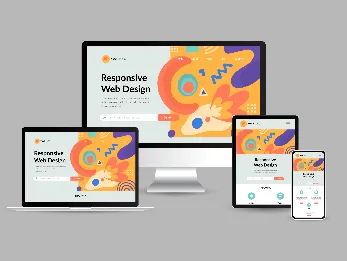Enhance Website Performance: Four Pillars for Success
4 mins | 05 Aug 2023

We all know Website performance is the main factor in ranking and highlighting websites to the public. If your website performs well, it helps increase traffic and audience engagement time onsite. Website performance depends on how the website is designed.
Here we talk about some of the most important factors to make website performance light, speed, and smooth. Suppose you have a brilliant product or service, a stunning website design, and captivating content that showcases your unique value proposition. You're ready to make a splash in the online market and captivate the hearts of your target audience. But you need to understand each pillar of website performance to avoid making silly mistakes in your website design.
So for that, here we talk about the four main pillars of website design. Which pillars help you to make your website perform well and help to rank your website on Google?
The first option is to focus on the Technology you must use for your website.
The second is to smooth the website user experience - UX and Usability. It is noted by the public and in the Google console how websites experience on different devices.
The third one is Conversation. If your customers get all answers to this question after website analysis, it will ensure the audience gains more interest in your website.
The last one is retention is the score of a successful website. If new visitors reach your site and get a good experience, then those visitors come again to your website analysis. This retention is the main success of your website design.
Here we must learn about the four main pillars of Website Design step by step. How to design a perfect website from the trash. With some useful tips and examples. Use the right technology, including choosing hosting providers and data validation and updates.
How to improve UI/UX to make the website attractive and smooth for great website performance. Make your website conversable for the audience to gain more attention, and last, we talk about how to build retention of visitors on our website.
2. Pillar One: Technology - Powering Peak Performance for Website Success
The first step in developing a website is to choose the right technology to create the right performing website.
Here we suggest to you how to start developing the website in a trite way.
I. Site Building and Development Processes:
Both front and backend development processes have a profound impact on a website's performance. Frontend performance, in particular, directly affects the user experience when accessing the homepage or clicking on internal links. Slow loading times or unresponsive pages can deter users and harm a site's reputation.
Site owners should regularly test and gather performance data to ensure high front-end performance. Whenever changes are made, whether it's adding new features or updating existing plugins, thorough testing is essential to monitor any potential negative impacts on performance. Website owners can improve their overall performance by continuously upgrading the technology while monitoring performance metrics.
II. A Right Hosting Choice:
Selecting a hosting provider can significantly influence both frontend and backend performance. Choosing a host that offers performance-enhancing features like caching or a global Content Delivery Network (CDN) is vital. Such features offload the burden from the internal development team, ensuring a smoother user experience.
III. Site Maintenance and Updates:
Regular updates are crucial for all types of software, and websites are no exception. Updates often introduce new functionalities or improve the performance of various components. However, even seemingly minor updates can adversely affect a well-maintained site, causing performance issues.
To mitigate this, website owners must remember to maintain the entire website or consider partnering with a reliable team for regular site maintenance. This includes monthly updates, compatibility checks, and adding new pages and features.
IV. Data Collection for Performance Improvement:
The collection of data plays a pivotal role in optimizing website performance. By extracting insights from various tools and datasets, web developers and administrators can gain a deeper understanding of their website's performance metrics and identify opportunities for improvement.
Let's explore some of the most valuable tools and resources available for gathering data to enhance website performance:
- New Relic: A Comprehensive Data Visibility Solution New Relic is a powerful tool offering an all-in-one data visibility solution across the entire tech stack. From server-side monitoring to user interactions, New Relic provides a holistic view of performance metrics, making pinpointing bottlenecks and potential issues easier. This tool simplifies monitoring real-time data, analyzing application performance, and identifying areas where optimizations can significantly impact.
- Google PageSpeed Insights (GPSI): Lab Test Results for Core Web Vitals Metrics GPSI is a widely-used tool offered by Google that focuses on web performance assessment. It provides lab test results for the Core Web Vitals metrics, which include Largest Contentful Paint (LCP), First Input Delay (FID), and Cumulative Layout Shift (CLS). These metrics are crucial for measuring user-centric performance. GPSI offers valuable insights into how well a website performs and where improvements can be made to deliver a smoother user experience.
- Chrome User Experience (CrUX) Reports: Real-World Performance Results CrUX reports offer real-world performance data from actual users. By aggregating user experience data from the Chrome browser, CrUX reports provide valuable insights into how users experience a website in different scenarios and over time. This data allows web developers to focus on improving performance for actual users and align their optimization efforts with real-world usage patterns.
- WebPageTest.org: Addressing Waterfall-Specific Data Concerns WebPageTest.org is an indispensable tool that addresses waterfall-specific data concerns by conducting website speed tests from various global locations using real browsers. This tool evaluates loading times and provides a detailed waterfall view of how each asset on a webpage loads. This granularity level helps understand which assets might be causing delays and guides optimization efforts effectively.
3. Pillar Two: UX and Usability - Crafting Intuitive Experiences for Every User
Pillar Two, dedicated to User Experience (UX) and usability, ensures website visitors' positive and satisfying experience. Website owners can create a seamless and enjoyable user journey by reducing friction through site speed optimization and UX writing improvements. In turn, this leads to higher user engagement and improved conversions and ultimately contributes to the overall success and performance of the website. Embracing these principles and continuously seeking ways to improve UX will undoubtedly set a solid foundation for a successful online presence.
I. Site Speed: A Crucial Indicator of User Satisfaction
Page speed plays a pivotal role in determining user satisfaction. Also, Google is now giving priority to the fast-loading website. Because slow speed also affects the user's mind, users become frustrated with using and searching on Google’s other pages when a page takes too long to load. Slow-responding website design reduces bounce rates and conversions. Also, the reason for not getting the audience back is slow website performance.
To ensure a positive user experience, website owners must prioritize site speed optimization. Techniques such as caching, image optimization, and server efficiency can significantly impact page loading times, making users more likely to engage with the site's content.
II. UX Writing: Communicating Clearly and Concisely
Traditional sales-centric copywriting no longer resonates with users constantly bombarded with marketing messages. The focus has shifted toward providing clear, concise information that fulfills users' needs. Website owners can improve the overall UX writing by reviewing the website's CTAs (Call-to-Actions), menus, and headers. Even seemingly minor changes can substantially impact user engagement and conversion rates. Striking the right balance between engaging content and direct communication can significantly enhance user satisfaction.
4. Pillar Three: Conversions - Driving Business Growth through Effective Conversion Strategies
A website needs to convert to perform as it should. Every pillar of website performance, including technology and user experience, is interconnected, and a lack of conversions could be a sign of underlying issues in these areas.
Making the website more conversable means playing with the audience’s thoughts. Taking an idea about what he/she wants or what type of product wants to find on the website. You can use many types of conversing ideas to ask or talk with the audience. Form filling technique, redirect to the new page for a particular topic, and more deep details on the small, engaging topic of the website.
I. Always be Testing on your website
Always try to find loopholes in your website. Find which page or topic is getting less traffic than the page. Make changes to content graphics, or product display. But there is more to the problem, reanalyze the changed page or topic and check the traffic your website gets. The main reason for implementing a new website is to make changes that the audience notes and comes to see. If you can achieve traffic on your changes and implements, your website implementation is successful.
Updating the website is like a newspaper morning. Many users have become addicted to the website because they know every week, or some say this website brings something new, which is the main reason for getting old traffic back. The audience always loves updates to read and write; for example, at every festival, many people go on Amazon or Flipkart and only check the offer without any need. Customers spend their time scrolling on this website. Also, as a result, your product gets some sales.
5. Pillar Four: Retention - The Key to Sustainable Business Growth
Many businesses agree that Retaining existing customers is significantly more cost-effective than acquiring new ones. A substantial portion of customer retention relies on the performance of your platform, not just during the initial sale but throughout the entire customer journey.
Creating an environment that fosters long-term customer success should be a priority. Satisfied customers are likelier to remain loyal to your brand and keep returning for repeat purchases.
While customer retention and churn are often perceived as platform or service-related issues, it's essential to recognize that churn can also be attributed to a more straightforward factor: attracting the wrong customers.
For example, Consider an e-commerce website that sells high-end luxury products. If the marketing strategies focus on attracting budget-conscious shoppers seeking discounts and deals, there's a high chance of attracting the wrong customer base. These customers might make one-time purchases but are unlikely to remain loyal or become brand advocates. On the other hand, if the marketing efforts target high-income individuals with a penchant for luxury items, they are more likely to have a long-lasting relationship with the brand, leading to higher customer retention rates.
6. Conclusion
The Four Pillars of Website Performance are interwoven, each pivotal in pursuing a high-performing website. As website owners, designers, and developers, our journey to optimal website performance demands unwavering dedication and a commitment to continuous improvement.
Understanding and prioritizing these pillars is key to crafting websites that function flawlessly and leave an indelible mark on users. In the fiercely competitive digital landscape, where attention spans are fleeting, exceptional website performance is the key to capturing and retaining the hearts of our audience.
The road to success is paved with constant vigilance, where we diligently test and refine our strategies. Website performance is not a one-time task; it's a dynamic process that requires consistent nurturing and improvement. By actively engaging in testing and gathering data, we gain insights into our users' behaviours, preferences, and pain points, empowering us to make data-driven decisions that elevate website performance to new heights.
So, let's take a step back and evaluate each pillar meticulously. From speed optimization that ensures lightning-fast loading times to visually captivating designs that mesmerize visitors, from crafting persuasive content that converts prospects into loyal customers to fostering a seamless user experience that keeps them coming back for more, these pillars form the bedrock of a successful website.
Author

Share
Share
Related

Polymers, Innovation, And A Modern Website: The Goldstab Organics Journey
5 mins : 10 Nov 2025

From Friction to Finish Line: The God of Sports Digital Transformation
6 mins : 17 Sept 2025

The Future Of Responsive Web Design: Emerging Trends, Innovations And Predictions In 2024
7 mins : 26 Apr 2024
Other Articles

Responsive Web Design: Understanding The Basics For Seamless User Experiences
7 mins : 29 Apr 2024

Everything You Should Know About The Ideal Screen Size For Responsive Design
6 mins : 26 Apr 2024

Enhance Your Web Design Creativity with Google Web Designer
4 mins : 17 Nov 2023
